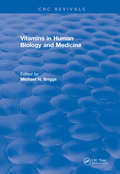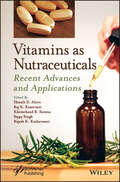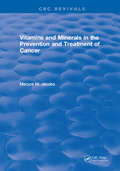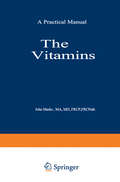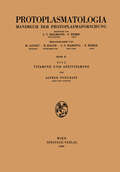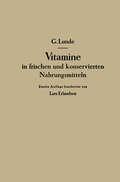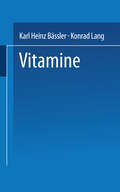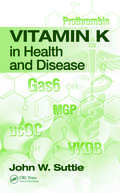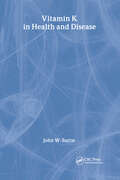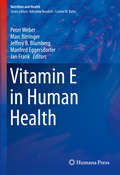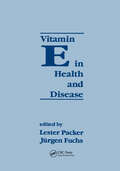- Table View
- List View
Vitiligo: A Monograph on the Basic and Clinical Science
by James NordlundThis monograph is a comprehensive expose of the disorder vitiligo. The book introduces the topic with a presentation about its cultural effects in the Middle East where vitiligo is exceptionally disabling to the affected person. Nehru as Prime Minister of India stated that vitiligo was a major impediment to the successful development of India. The book includes sections on the definition of vitiligo based on a consensus of world experts on vitiligo. There is a complete description of its clinical manifestations including the extracutaneous sites by world experts. Differentiation of vitiligo from other forms of depigmentation associated with malignancies is included with sufficient photographs to document differences. A section will present the physiological changes associated with depigmentation - a little known phenomena. The complete histology, differential diagnosis and animal models are major sections. The animal models are important in formulating theories about the causes of vitiligo. Most clinicians will find this section very informative. The book finishes with a thorough treatise on the principles of therapy.
Vitiligo
by Mauro Picardo Alain TaïebVitiligo has been, until recently, a rather neglected area in dermatology and medicine. Patients complain about this situation, which has offered avenues to quacks, and has led to the near orphan status of the disease. The apparently, simple and poorly symptomatic presentation of the disease has been a strong disadvantage to its study, as compared to other common chronic skin disorders such as psoriasis and atopic dermatitis. Vitiligo is still considered by doctors as a non disease, a simple aesthetic problem. A good skin-based angle of attack is also lacking because generalized vi- ligo is clearly epitomizing the view of skin diseases as simple targets of a systemic unknown dysregulation (diathesis), re? ecting the Hippocratic doctrine. This view has mostly restricted vitiligo to the manifestation of an auto-immune diathesis in the past 30 years. Thus, skin events, which are easily detected using skin biospies in most other situations, have not been precisely recorded, with the argument that a clinical diagnosis was suf? cient for the management (or most commonly absence of mana- ment) of the patient. This book is an international effort to summarize the information gathered about this disorder at the clinical, pathophysiological and therapeutic levels. Its primary aim is to bridge current knowledge at the clinical and investigative level, to point to the many unsolved issues, and to delineate future priorities for research.
Vitiligo
by Alain Taïeb Mauro PicardoSince the first edition of this book was published, new knowledge has been gained on Vitiligo. This widely revised and updated second edition, written by worldwide experts in the field, fully reflects this progress. The apparently, simple and poorly symptomatic presentation of the disease has been a strong disadvantage to its study, as compared to other common chronic skin disorders such as psoriasis and atopic dermatitis. A good skin-based angle of attack is also lacking because generalized Vitiligo is clearly epitomizing the view of skin diseases as simple targets of a systemic unknown dysregulation (diathesis). This view has mostly restricted Vitiligo to the manifestation of an auto-immune diathesis and skin events, which are easily detected using skin biopsies in most other situations, have not been precisely recorded, with the argument that a clinical diagnosis was sufficient for the management of the patient with Vitiligo. This richly illustrated second edition reflects the constant international effort to share the information gathered about this disorder at the clinical, pathophysiological and therapeutic levels. Its aim still being to bridge current knowledge at the clinical and investigative level, to point to the many unsolved issues, and to delineate future priorities for research.
Vitellogenin in Fishes- Diversification, Biological Properties, and Future Perspectives
by Vaseeharan Baskaralingam Rapeepun VanichviriyakitThis book provides basic and advanced information on vitellogenin in fish. The proposed book discusses the history of vitellogenin, previtellogenesis, their diversification and classification in fishes, and tools for their identification and characterization. Further, their functional aspects in oogenesis and its regulatory mechanism, role as the immunocompetent molecule, and reproductive strategies are discussed. The book further examines vitellogenin as a hormone and biomarker, its related egg yolk proteins, and its mechanism on molecular cloning and induction. In addition, the book discusses its role in the disruption of the endocrine system in fish, its biological activities, its multivalent mechanism in marine and freshwater fishes, and its impact on the growth of ornamental fishes. Moreover, this book elaborates on the multiple vitellogenin genes, each with unique promoter regions and varying sensitivity to induction by estradiol, and multiple Vtg proteins themselves, with variable degrees of post-translational modification. As such, this book is helpful for researchers and students interested in the reproduction of fishes and reproductive biology.
Vitamins In Human Biology and Medicine (CRC Press Revivals)
by Michael H. BriggsIt is the purpose of this book to try to offer a modern perspective on the importance of vitamins in human biology and medicine. There have been recent revivals of attempts to use vitamins as therapeutic agents by administering doses many times the recommended allowance. This use or 'megavitamin therapy' is reviewed by Dr. Reynold Spector, with particular emphasis on vitamin entry to the central nervous system. Of related interest is the chapter by Dr. John Blass discussing central nervous system manifestations of thiamin deficiency, and also the contribution by Ms. Fiona Cumming and clinical toxicity of vitamin supplementation.
Vitamins In Human Biology and Medicine: Vitamins In Human Biology And Medicine (1981) (CRC Press Revivals)
by Michael H. BriggsIt is the purpose of this book to try to offer a modern perspective on the importance of vitamins in human biology and medicine. There have been recent revivals of attempts to use vitamins as therapeutic agents by administering doses many times the recommended allowance. This use or 'megavitamin therapy' is reviewed by Dr. Reynold Spector, with particular emphasis on vitamin entry to the central nervous system. Of related interest is the chapter by Dr. John Blass discussing central nervous system manifestations of thiamin deficiency, and also the contribution by Ms. Fiona Cumming and clinical toxicity of vitamin supplementation.
Vitamins in Animal and Human Nutrition
by Lee Russell McDowellVitamins in Animal and Human Nutrition contains concise, up-to-date information on vitamin nutrition for both animals and humans. The author defines these nutrients and describes their fascinating discovery, history and relationship to various diseases and deficiencies. Discussion of vitamins also includes their chemical structure, properties and antagonists; analytical procedures; metabolism; functions; requirements; sources; supplementation and toxicity. Vitamin-like substances, essential fatty acids and vitamin supplementation considerations are also examined. This book will be useful worldwide as a textbook and as an authoritative reference for research and extension specialists, feed manufacturers, teachers, students and others. It provides a well-balanced approach to both animal and clinical human nutrition and compares chemical, metabolic and functional aspects of vitamins and their practical and applied considerations. A unique feature of the book is its description of the implications of vitamin deficiencies and excesses and the conditions that might occur in human and various animal species.
Vitamins as Nutraceuticals: Recent Advances and Applications
by Eknath D. Ahire Raj K. Keservani Khemchand R. Surana Sippy Singh Rajesh K. KesharwaniVitamins as Nutraceuticals The book examines the development of nutraceutical products featuring maximizing the vitamin benefits to human health and various health conditions. Since vitamins are widely predicted to be one of the most significant nutritional advancements over the next 25 years, the editors of this book have brought together renowned experts in the field to provide a single authoritative resource for the nutraceutical sector. It is being published at a time when there is a pressing need to address the rising number of cases of nutritional deficiency disorders and the high number of deaths caused by a lack of knowledge or a deviation from healthy eating habits. The book contains 12 chapters and begins by defining and classifying the field of vitamins, with a focus on legislative issues in both the United States and the European Union. In addition to discussing recent advances and applications, this book also includes scientific information on the importance of vitamins as nutraceuticals to human health, as well as the potential mechanisms of nutraceuticals in illness prevention, management, and control. The focus is on vitamins as nutraceuticals for health conditions such as human nutrition, pregnancy, oral health, anemia, and blindness. The book also explores the structure and function of various vitamins and covers the impact of various vitamins on immunity and the nutraceutical properties of seaweed vitamins and marine-derived sources of nutritional vitamins. The beneficial effects of water-soluble vitamins in nutrition, health promotion, and nutraceutical potential of fat-soluble vitamins, are also discussed. Audience The book will be read by a range of researchers and industry scientists such as vitamin formulators, food scientists and food manufacturers, as well as those in the pharmaceutical industry, nanotech industry, novel drug delivery research laboratories, and the health sector.
Vitamins as Nutraceuticals: Recent Advances and Applications
by Eknath D. Ahire Raj K. Keservani Khemchand R. Surana Sippy Singh Rajesh Kumar KesharwaniVitamins as Nutraceuticals The book examines the development of nutraceutical products featuring maximizing the vitamin benefits to human health and various health conditions. Since vitamins are widely predicted to be one of the most significant nutritional advancements over the next 25 years, the editors of this book have brought together renowned experts in the field to provide a single authoritative resource for the nutraceutical sector. It is being published at a time when there is a pressing need to address the rising number of cases of nutritional deficiency disorders and the high number of deaths caused by a lack of knowledge or a deviation from healthy eating habits. The book contains 12 chapters and begins by defining and classifying the field of vitamins, with a focus on legislative issues in both the United States and the European Union. In addition to discussing recent advances and applications, this book also includes scientific information on the importance of vitamins as nutraceuticals to human health, as well as the potential mechanisms of nutraceuticals in illness prevention, management, and control. The focus is on vitamins as nutraceuticals for health conditions such as human nutrition, pregnancy, oral health, anemia, and blindness. The book also explores the structure and function of various vitamins and covers the impact of various vitamins on immunity and the nutraceutical properties of seaweed vitamins and marine-derived sources of nutritional vitamins. The beneficial effects of water-soluble vitamins in nutrition, health promotion, and nutraceutical potential of fat-soluble vitamins, are also discussed. Audience The book will be read by a range of researchers and industry scientists such as vitamin formulators, food scientists and food manufacturers, as well as those in the pharmaceutical industry, nanotech industry, novel drug delivery research laboratories, and the health sector.
Vitamins and Minerals in the Prevention and Treatment of Cancer
by Maryce M. JacobsThis book provides researchers and practitioners with a unique collection of current research on the role of vitamins and micronutrients in cancer prevention and treatment. New theories are discussed, including a hypothesis that dietary factors may protect against genetically predisposed cancers. Mechanisms by which different vitamins and minerals appear to inhibit carcinogenesis or cell transformation are described, including vitamins A, C, E, and selenium protection against oxidative stress by induction of enzymes as catalase and dismutase or inteference with free radical mechanisms; organosulfur compound inhibition of P450 activation enzymes or enhancement of detoxification enzymes; metal ion effects in the modulation of gene expression by site-specific binding of Zn-finger loop domains; B-carotene metabolite up-regulation of gap junctional communication between cells; and vitamin D3 elimination of amplified oncogenes or drug resistant genes. The book also reviews literature implicating a possible relationship between potassium and the control of cancer. Other information presented includes a discussion of contemporary technologies and data associating lipotrope deficiencies with alterations in xenobiotic metabolism, nucleic acid methylation, purine and pyrimidine synthesis, signal transduction, and chromosome anomalies.
Vitamins and Minerals in the Prevention and Treatment of Cancer
by Maryce M. JacobsThis book provides researchers and practitioners with a unique collection of current research on the role of vitamins and micronutrients in cancer prevention and treatment. New theories are discussed, including a hypothesis that dietary factors may protect against genetically predisposed cancers. Mechanisms by which different vitamins and minerals appear to inhibit carcinogenesis or cell transformation are described, including vitamins A, C, E, and selenium protection against oxidative stress by induction of enzymes as catalase and dismutase or inteference with free radical mechanisms; organosulfur compound inhibition of P450 activation enzymes or enhancement of detoxification enzymes; metal ion effects in the modulation of gene expression by site-specific binding of Zn-finger loop domains; B-carotene metabolite up-regulation of gap junctional communication between cells; and vitamin D3 elimination of amplified oncogenes or drug resistant genes. The book also reviews literature implicating a possible relationship between potassium and the control of cancer. Other information presented includes a discussion of contemporary technologies and data associating lipotrope deficiencies with alterations in xenobiotic metabolism, nucleic acid methylation, purine and pyrimidine synthesis, signal transduction, and chromosome anomalies.
Vitamins and Cancer: Human Cancer Prevention by Vitamins and Micronutrients (Experimental Biology and Medicine #10)
by Jr. Meyskens Kedar N. PrasadIn the past five years, a surprising and intense resurgence in interest in vitamins and other micronutrients and their role in health and dis ease has occurred. The recognition has emerged that vitamins not only are essential for life ·in that severe nutritional deficiencies occur in their absence, but that these compounds may also serve as natural inhibitors of cancer. Synthetic alterations of the basic vitamin A mole cule have also resulted in the production of compounds that are more potent as anticancer agents than the natural substance and may have substantial therapeutic activity as well. Whether other vita mins can be changed or altered to produce a better anticancer effect than the native compound has been little explored to date, but should be a fruitful pursuit for future study. In our concluding remarks to the First International Conference in 1982, we speculated that rapid advances in our understanding of vi tamins would occur in the next few years and that large-scale inter vention trials of vitamins as preventive agents in defined human pop ulations would be started. This anticipated generation of data on vitamins and their interactions has proceeded rapidly and the impor tance of interactions between vitamins and other micronutrients in the prevention setting has become better appreciated. Currently, more than 25 intervention trials with a variety of target populations using vitamins and other micronutrients have been started, but it re mains too early for meaningful analysis of the results to date.
Vitamins: Their Role in the Human Body
by George F. BallThis single-source reference draws together the current knowledge of the vitamins’ biological properties in the context of human nutrition. Vitamins are co-enzymes, antioxidants or precursors of hormones and are therefore involved in a great many biochemical and physiological processes. They play a vital role in the maintenance of health, and there is evidence that dietary sources of vitamins have beneficial effects in the prevention of heart-related diseases, bone diseases and possibly cancer.Following introductory chapters on historical and nutritional aspects of vitamins, the next four chapters cover relevant and detailed aspects of physiology and functional anatomy, biochemistry, immunology and the regulation of protein synthesis by nuclear hormone receptors. These background chapters, supported by a glossary of terms, provide the scientific principles upon which vitamin functions are based. The following thirteen chapters deal with each vitamin in turn. Subject areas include chemical structure, intestinal absorption, transport, metabolism, biochemical and physiological actions, immunoregulatory properties, deficiency-related diseases and potential toxicity. An extensive bibliography refers the reader to the original research literature.Vitamins is aimed at nutritionists, biochemists, physiologists and physicians whether they be researchers, teachers or students. Food scientists, food technologists and many others working in the health professions will also find much of use and interest in the book. The inclusion of the theoretical principles in the background chapters makes the book an ideal starting point for those working outside the area who need a solid overview of the subject.
The Vitamins: Their Role in Medical Practice
by J. MarksThis book has been designed, as its title implies, as a practical book for medical practitioners, although it should be of interest to medical students and nutritionists. It attempts to provide essential information about this important group of substances rather than be an all embracing monograph on the subject. For this reason biochemical and physiological considera tions have been kept to a minimum, and aspects of animal disorders and animal husbandry have not been considered. The material is often presented in a rather dogmatic fashion and, with rare exceptions, references are not included since this makes reading more difficult. The exceptions, where references are provided, are the therapeutic claims, and the series of recent studies which have indicated that vitamin deficiencies are still widely present among certain groups of the population of many industrially developed countries. To add to this reference list there is a reading list which has been selected to give key books, reviews with extensive bibliography and important articles over the past 10 years. From this reading list it is possible to trace most of the literature on the vitamins since they were first described over half a century ago.
Vitamine und Mangelkrankheiten: Ein Kapitel aus der menschlichen Ernährungslehre (Verständliche Wissenschaft #27 )
by Hermann RudyDieser Buchtitel ist Teil des Digitalisierungsprojekts Springer Book Archives mit Publikationen, die seit den Anfängen des Verlags von 1842 erschienen sind. Der Verlag stellt mit diesem Archiv Quellen für die historische wie auch die disziplingeschichtliche Forschung zur Verfügung, die jeweils im historischen Kontext betrachtet werden müssen. Dieser Titel erschien in der Zeit vor 1945 und wird daher in seiner zeittypischen politisch-ideologischen Ausrichtung vom Verlag nicht beworben.
Vitamine und Mangelkrankheiten: Ein Kapitel aus der menschlichen Ernährungslehre (Verständliche Wissenschaft #27)
by Hermann RudyDieser Buchtitel ist Teil des Digitalisierungsprojekts Springer Book Archives mit Publikationen, die seit den Anfängen des Verlags von 1842 erschienen sind. Der Verlag stellt mit diesem Archiv Quellen für die historische wie auch die disziplingeschichtliche Forschung zur Verfügung, die jeweils im historischen Kontext betrachtet werden müssen. Dieser Titel erschien in der Zeit vor 1945 und wird daher in seiner zeittypischen politisch-ideologischen Ausrichtung vom Verlag nicht beworben.
Vitamine und Mangelkrankheiten: Ein Kapitel aus der menschlichen Ernährungslehre (Verständliche Wissenschaft #27)
by Hermann RudyDieser Buchtitel ist Teil des Digitalisierungsprojekts Springer Book Archives mit Publikationen, die seit den Anfängen des Verlags von 1842 erschienen sind. Der Verlag stellt mit diesem Archiv Quellen für die historische wie auch die disziplingeschichtliche Forschung zur Verfügung, die jeweils im historischen Kontext betrachtet werden müssen. Dieser Titel erschien in der Zeit vor 1945 und wird daher in seiner zeittypischen politisch-ideologischen Ausrichtung vom Verlag nicht beworben.
Vitamine und Antivitamine (Protoplasmatologia Cell Biology Monographs #2 / B/2 / b b)
by Alfred PongratzVitamine in frischen und konservierten Nahrungsmitteln
by Gulbrand LundeDieser Buchtitel ist Teil des Digitalisierungsprojekts Springer Book Archives mit Publikationen, die seit den Anfängen des Verlags von 1842 erschienen sind. Der Verlag stellt mit diesem Archiv Quellen für die historische wie auch die disziplingeschichtliche Forschung zur Verfügung, die jeweils im historischen Kontext betrachtet werden müssen. Dieser Titel erschien in der Zeit vor 1945 und wird daher in seiner zeittypischen politisch-ideologischen Ausrichtung vom Verlag nicht beworben.
Vitamine in frischen und konservierten Nahrungsmitteln
by Gulbrand Lunde Lars ErlandsenDieser Buchtitel ist Teil des Digitalisierungsprojekts Springer Book Archives mit Publikationen, die seit den Anfängen des Verlags von 1842 erschienen sind. Der Verlag stellt mit diesem Archiv Quellen für die historische wie auch die disziplingeschichtliche Forschung zur Verfügung, die jeweils im historischen Kontext betrachtet werden müssen. Dieser Titel erschien in der Zeit vor 1945 und wird daher in seiner zeittypischen politisch-ideologischen Ausrichtung vom Verlag nicht beworben.
Vitamine: Eine Einführung für Studierende der Medizin, Biologie, Chemie, Pharmazie und Ernährungswissenschaft (Uni-Taschenbücher)
by Karl Heinz LangVitamin K in Health and Disease
by John W. SuttieVitamin K: Past, Present, Future Essential for normal blood coagulation, possible roles in bone, vascular, and tumor metabolism, and a nutrient critical to the health of the newborn infant -- these are just some of the many health-promoting aspects of Vitamin K. Vitamin K in Health and Disease navigates the exciting research venues that have opened
Vitamin K in Health and Disease
by John W. SuttieVitamin K: Past, Present, Future Essential for normal blood coagulation, possible roles in bone, vascular, and tumor metabolism, and a nutrient critical to the health of the newborn infant -- these are just some of the many health-promoting aspects of Vitamin K. Vitamin K in Health and Disease navigates the exciting research venues that have opened
Vitamin E in Human Health (Nutrition and Health)
by Peter Weber Marc Birringer Jeffrey B. Blumberg Manfred Eggersdorfer Jan FrankVitamin E is a well described and established fat-soluble essential micronutrient and as such has to be provided to the human body on a regular basis in order to avoid deficiency and maintain a healthy status. This is well established and also reviewed in a number of publications. However, a huge body of evidence has accumulated over the last decade, or so, which provides new insights on the mode of action of vitamin E, and the biological role of the tocopherol isomers, and sheds new light on the role of vitamin E in human health. Both fundamental knowledge gain and new data on the role and challenges of vitamin E as an essential micronutrient, including emerging evidence on clinical benefits, will be addressed to put this essential micronutrient in the appropriate perspective. Given this level of new evidence which has emerged over the recent years, a book on vitamin E will put into perspective the concerns which have been raised on vitamin E and which resulted in a misinformation and confusion of the public regarding the importance of vitamin E for human health. This book will reemphasize that Vitamin E is clearly required for human health and its inadequacy leads to increased risk of a variety of diseases. In addition new data of non-communicable diseases (NCD) dependent on vitamin E status show that a lifetime of low intake increases risks of development, severity and complications of NCDs. This text will put the vitamin E case into an up-to-date, science based, applicable real-life perspective and offer pragmatic solutions for its safe and personalized use beyond the various methodological and statistical controversies. The purpose of this book is also to raise awareness not only in the nutrition and medical community, but also in the public media that there are a number of health conditions where an increased intake of vitamin E can be of potential importance. Further this review should also stimulate funding organizations and agencies to increase their support for vitamin E research in order to facilitate the further exploration of the safe and efficacious use of this essential micronutrient.
Vitamin E in Health and Disease: Biochemistry and Clinical Applications
by Lester PackerProbes developments and trends in research and clinical applications of vitamin E, discussing its chemistry and biochemistry and natural occurence in nuts, seeds, whole grains and vegetable and fish-liver oils. The book covers new findings on the role of vitamin E as a biological response modifier.




